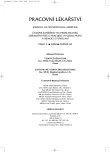A Videosequential Study of Sitting in front of the Computer
Authors:
M. Vrbík 1; I. Müller 2; J. Prostředník 1; R. Pomp 1; D. Linhartová 3
Authors‘ workplace:
Ústav nábytku, designu a bydlení, Lesnická a dřevařská fakulta Mendlovy zemědělské a lesnické univerzitě v Brně, vedoucí ústavu doc. Dr. Ing. Petr Brunecký
1; Ortopedická klinika Fakultní nemocnice Brno-Bohunice, přednosta Doc. MUDr. Martin Krbec, CSc.
2; Oddělení sociálních věd, Institut celoživotního vzdělávání Mendlovy zemědělské a lesnické univerzitě v Brně, vedoucí oddělení PhDr. Dana Linhartová, CSc.
3
Published in:
Pracov. Lék., 60, 2008, No. 3, s. 106-110.
Category:
Original Papers
Overview
An interdisciplinary group of experts analyzed videosequential records of 12 volunteers – designers working for 8 hours at the computer. When analyzing records the focus was especially placed on changes of the posture of the trunk, neck and head, pelvis and lower extremities, on the trunk rotation, breaks and positions of upper extremities. The Pinnacle software was used for the analysis and editing of the video. The authors present their results in graphs which point out to the increase of the load of operators after 6 hours of work. The study supports preventive programme for people working with computers and looks for optimal ways of ergonomic dynamic sitting. The results correspond to smaller American studies and the directive of the Council of Europe No. 90/2270 EEC.
Key words:
ergonomic sitting, videoseqentional study, back pain, visual display terminals, administrative PC workplace
Sources
1. CARTER, J. B., BANNISTER, E. W. Musculoskeletal problems in VDT work: a review. Ergonomics, 1994, 10, s. 1623–1648.
2. GILBERTOVÁ, S., MATOUŠEK, O. Ergonomie. Optimalizace lidské činnosti. Praha : Grada Publishing, 2002. 239 s., ISBN 80-247-0226-6.
3. GILBERTOVÁ, S. Práce vsedě – ergonomické a rehabilitační aspekty. Stolařský magazín, 2005, 12, s. 58–59.
4. HORNÁČEK, K., ADAMCOVÁ, N., HLAVAČKA, F., ČEPÍKOVÁ, M. Dynamický sed zmierňuje bolest a upravuje posturálnu funkciu u pacientov s funkčnou patológiou pohybového systému. Rehabilitácia, 2005, 1, s. 31–36.
5. MÜLLER, I., MÜLLEROVA, B. Vertebrogenní algické syndromy. Update, 2005, 1, s .6–20.
6. MÜLLER, I., CHLUBNOVÁ, B. Potíže pohybového ústrojí a jiné zdravotní problémy pracovnic ve zdravotnictví. Acta Chir. orthop. Traum. čech., 1994, 6, s. 362–364.
7. PANERO, J., ZELNIK, M. Human Dimension and Interior Space. Aktualizované vydání, London : Architectural press Ltd., 2002. 320 s. ISBN 0-8230-7271-1.
8. PROKOPOVÁ, H., MÜLLER, I., MAŇÁK, H. Byt, který se vám přizpůsobí. Brno : ERA, 2007. 129 s., ISBN 978--80-7366-106-9.
9. RUČKOVÁ, Z. Projevy nevhodného zatížení páteře při sedavém zaměstnání. Rehabilitácia, 2002, 2, s. 72–77.
10. VRBÍK, M. Vývoj řešení dynamického sezení – židle na administrativním pracovišti. In Disertační práce, Brno: MZLU v Brně, 2007, 110 s.
Labels
Hygiene and epidemiology Hyperbaric medicine Occupational medicineArticle was published in
Occupational Medicine

2008 Issue 3
Most read in this issue
- Mental Work Load and Legislation
- Professional Rhinitis from the Perspective of the Occupational Physician
- A Review of Professional Diseases from Vibrations Reported in the Hradec Králové Region in 1997–2006 and the Role of the Occupational Health Care
- From the History of the Organizational Protection of Coal-miners of the Ostrava-Karvina Region (OKR) against Consequences Related to the Risk of Fibrogenic Dust
